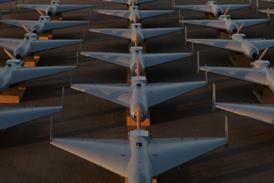GEORGIA INSTITUTE of Technology is developing an inexpensive millimetre-wave (MMW) radar antenna suitable for use in aircraft all-weather landing systems and missile seekers.
A prototype built by the Atlanta-based institute is believed to be the first "Rotman lens" to operate at MMW frequencies - as high as 37GHz.
Most MMW antennas use mechanical scanning, which Georgia Tech says give rise to response and reliability problems, while alternative electronic scanning techniques, using phase shifters, are costly and introduce losses. The Rotman-lens antenna has no moving parts, no phase shifters and can be made from plastic, the institute says. Throughput loss and sidelobe emissions are "very low", it adds.
A Rotman lens focuses and directs the radar beam by passing the energy through a pair of parallel plates, which are shaped like a lens. Beam-forming or focal ports are located on one side and array ports on the opposite side, each connected to an antenna element. Energy fed into a specific focal port emerges from the antenna elements to form a beam along a particular direction. Switching the input between focal ports steers the beam electronically across a 45í arc.
Rotman-lens "microstrip" antennas have been produced which operate at frequencies up to 18GHz, but are unsuitable for the MMW waveband because of high losses. Georgia Tech's prototype antenna was milled from an aluminium block using electric-discharge techniques accurate to 0.0127mm. Production antennas could be hot-pressed in plastic and coated with a conductor, such as gold, the institute says.
Source: Flight International























